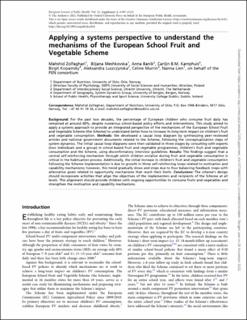| dc.contributor.author | Zolfaghari, Mahshid | |
| dc.contributor.author | Meshkovska, Biljana | |
| dc.contributor.author | Banik, Anna | |
| dc.contributor.author | Kamphuis, Carlijn B.M. | |
| dc.contributor.author | Kopainsky, Birgit | |
| dc.contributor.author | Luszczynska, Aleksandra | |
| dc.contributor.author | Murrin, Celine M. | |
| dc.contributor.author | Lien, Nanna | |
| dc.date.accessioned | 2022-12-12T12:17:37Z | |
| dc.date.available | 2022-12-12T12:17:37Z | |
| dc.date.created | 2022-11-29T21:19:04Z | |
| dc.date.issued | 2022 | |
| dc.identifier.issn | 1101-1262 | |
| dc.identifier.uri | https://hdl.handle.net/11250/3037250 | |
| dc.description.abstract | Background
For the past two decades, the percentage of European children who consume fruit daily has remained at around 40%, despite numerous school-based policy efforts and interventions. This study aimed to apply a systems approach to provide an integrated perspective of the mechanisms of the European School Fruit and Vegetable Scheme (the Scheme) to understand better how to increase its long-term impact on children’s fruit and vegetable consumption.
Methods
We developed a causal loop diagram by synthesizing peer-reviewed articles and national government documents related to the Scheme, following the conceptualization steps of system dynamics. The initial causal loop diagrams were then validated in three stages by consulting with experts (two individuals and a group) in school-based fruit and vegetable programmes, children's fruit and vegetable consumption and the Scheme, using disconfirmatory interview guidelines.
Results
The findings suggest that a central self-reinforcing mechanism through which children socialize during fruit and vegetable consumption is critical in the habituation process. Additionally, the initial increase in children’s fruit and vegetable consumption following the Scheme implementation is due to growth in three self-reinforcing loops related to motivation and capability mechanisms; however, this trend gradually slows and stops due to four balancing feedback loops with alternative goals related to opportunity mechanisms that reach their limits.
Conclusions
The scheme's design should incorporate activities that align the objectives of the implementers and recipients of the Scheme at all levels. This alignment should provide children with ongoing opportunities to consume fruits and vegetables and strengthen the motivation and capability mechanisms. | en_US |
| dc.language.iso | eng | en_US |
| dc.publisher | Oxford University Press | en_US |
| dc.rights | Navngivelse 4.0 Internasjonal | * |
| dc.rights.uri | http://creativecommons.org/licenses/by/4.0/deed.no | * |
| dc.title | Applying a systems perspective to understand the mechanisms of the European School Fruit and Vegetable Scheme | en_US |
| dc.type | Journal article | en_US |
| dc.type | Peer reviewed | en_US |
| dc.description.version | publishedVersion | en_US |
| dc.rights.holder | Copyright 2022 The Author(s) | en_US |
| cristin.ispublished | true | |
| cristin.fulltext | original | |
| cristin.qualitycode | 1 | |
| dc.identifier.doi | https://doi.org/10.1093/eurpub/ckac054 | |
| dc.identifier.cristin | 2084764 | |
| dc.source.journal | European Journal of Public Health | en_US |
| dc.source.pagenumber | iv107–iv113 | en_US |
| dc.identifier.citation | European Journal of Public Health. 2022, 32, iv107–iv113. | en_US |
| dc.source.volume | 32 | en_US |

